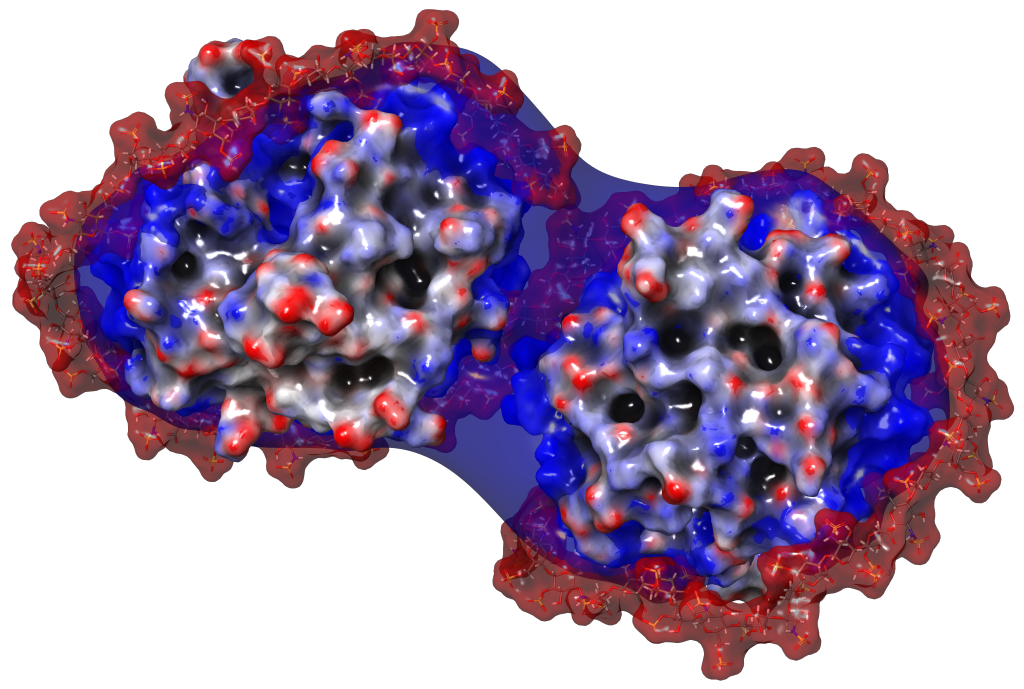 Heparin-related glycosaminoglycans (GAGs) hold enormous promise in the field of regenerative medicine, and also are a largely unexploited source of therapeutic agents to address a range of other medically important conditions including cancer and neurodegenerative diseases. Nevertheless, their practical utilization in the clinic is still confined to anticoagulants, while progress in other areas remains relatively modest. The great challenge presented by these biopolymers to medicine and, more broadly, to structural biology is due in large part to their enormous structural heterogeneity, which is mirrored by their multiple roles in modulating angiogenesis, cell adhesion, embryogenesis, inflammation, metastasis and wound healing. Despite extensive research efforts, clear understanding of how various structural features modulate function of these biopolymers remains wanting, arguably because the inquiry was designed using the framework of the lock-and-key model, a paradigm that had been tremendously successful in structural biology applied to proteins. However, this approach fails to recognize that the dramatically higher level of structural diversity exhibited by GAGs has functional importance. In our studies of GAG/protein interactions we move away from the notion of well-defined sterically complementary binding sites and emphasize a greater role of polyvalent electrostatics. We aim at deciphering the determinants of GAG/protein interactions and understanding how they fine-tune the binding process. This is done without either limiting the structural space to a few precisely defined GAG molecules or reducing the conformational space to a few static snapshots available from crystal structures. We use a combination of bottom-up and top-down approaches to study protein/GAG interactions, the former focusing on relatively well-defined subsets of short heparin oligomers obtained by affinity separations, and the latter aimed at intact heparin. The experimental work is complemented by high-level molecular dynamics simulations to obtain a high-resolution and dynamic depiction of the interaction process.
Heparin-related glycosaminoglycans (GAGs) hold enormous promise in the field of regenerative medicine, and also are a largely unexploited source of therapeutic agents to address a range of other medically important conditions including cancer and neurodegenerative diseases. Nevertheless, their practical utilization in the clinic is still confined to anticoagulants, while progress in other areas remains relatively modest. The great challenge presented by these biopolymers to medicine and, more broadly, to structural biology is due in large part to their enormous structural heterogeneity, which is mirrored by their multiple roles in modulating angiogenesis, cell adhesion, embryogenesis, inflammation, metastasis and wound healing. Despite extensive research efforts, clear understanding of how various structural features modulate function of these biopolymers remains wanting, arguably because the inquiry was designed using the framework of the lock-and-key model, a paradigm that had been tremendously successful in structural biology applied to proteins. However, this approach fails to recognize that the dramatically higher level of structural diversity exhibited by GAGs has functional importance. In our studies of GAG/protein interactions we move away from the notion of well-defined sterically complementary binding sites and emphasize a greater role of polyvalent electrostatics. We aim at deciphering the determinants of GAG/protein interactions and understanding how they fine-tune the binding process. This is done without either limiting the structural space to a few precisely defined GAG molecules or reducing the conformational space to a few static snapshots available from crystal structures. We use a combination of bottom-up and top-down approaches to study protein/GAG interactions, the former focusing on relatively well-defined subsets of short heparin oligomers obtained by affinity separations, and the latter aimed at intact heparin. The experimental work is complemented by high-level molecular dynamics simulations to obtain a high-resolution and dynamic depiction of the interaction process.
This work will allow the therapeutic potential of heparin-like GAGs to be exploited more efficiently in areas as diverse as regenerative medicine, inflammation, neurodegenerative disorders and oncology, and we will welcome any opportunity for collaborations in these fields.
Representative publications
Yang, Y. Du, D.G. Ivanov, C. Niu, R. Clare, J.E. Smith, I. Nazy and I.A. Kaltashov. Molecular architecture and platelet-activating properties of small immune complexes assembled on heparin and platelet factor 4. Comm. Biol. 2024, 7, 308 (doi: 10.1038/s42003-024-05982-4)
D. G. Ivanov, N. Ivetic, Y. Du, S.N. Nguyen, S.H. Le, D. Favre, I. Nazy, I.A. Kaltashov. Reverse Engineering of a Pathogenic Antibody Reveals the Molecular Mechanism of Vaccine-Induced Immune Thrombotic Thrombocytopenia. J. Am. Chem. Soc. 2023, 145, 25203-25213 (doi: 10.1021/jacs.3c07846)
C. Niu, Y. Du and I.A. Kaltashov. Towards better understanding of the heparin role in NETosis: Feasibility of using native mass spectrometry to monitor interactions of neutrophil elastase with heparin oligomers. Int. J. Mass Spectrom. 2021, 463, 116550
Yang, Y. Du and I.A. Kaltashov. The utility of native MS for understanding the mechanism of action of repurposed therapeutics in COVID-19: heparin as a disruptor of the SARS-CoV-2 interaction with its host cell receptor. Anal. Chem. 2020, 92, 10930-10934
Niu, Y. Yang, A. Huynh, I. Nazy and I.A. Kaltashov. Platelet factor 4 interactions with short heparin oligomers: implications for folding and assembly. Biophys. J., 2020, 119, 1371-1379
C. Niu, Y. Zhao, C.E. Bobst, S.N. Savinov and I.A. Kaltashov. Identification of protein recognition elements within heparin chains using enzymatic foot-printing in solution and on-line SEC/MS. Anal. Chem. 2020, 92, 7565–7573
B.B. Minsky, R.R. Abzalimov, C. Niu, Y. Zhao, Z. Kirsch, P.L. Dubin, S.N. Savinov, and I.A. Kaltashov. Mass spectrometry reveals a multifaceted role of glycosaminoglycan chains in factor Xa inactivation by antithrombin. Biochemistry, 2018, 57, 4880-4890
B.B. Minsky, P.L. Dubin and I.A. Kaltashov. Electrostatic forces as dominant interactions between proteins and polyanions: an ESI-MS study of fibroblast growth factor binding to heparin oligomers. J. Am. Soc. Mass Spectrom., 2017, 28, 758-767
Y. Zhao, R.R. Abzalimov, and I.A. Kaltashov. Interactions of intact unfractionated heparin with its client proteins can be probed directly using native electrospray ionization mass spectrometry. Anal. Chem. 2016, 88, 1711-1718